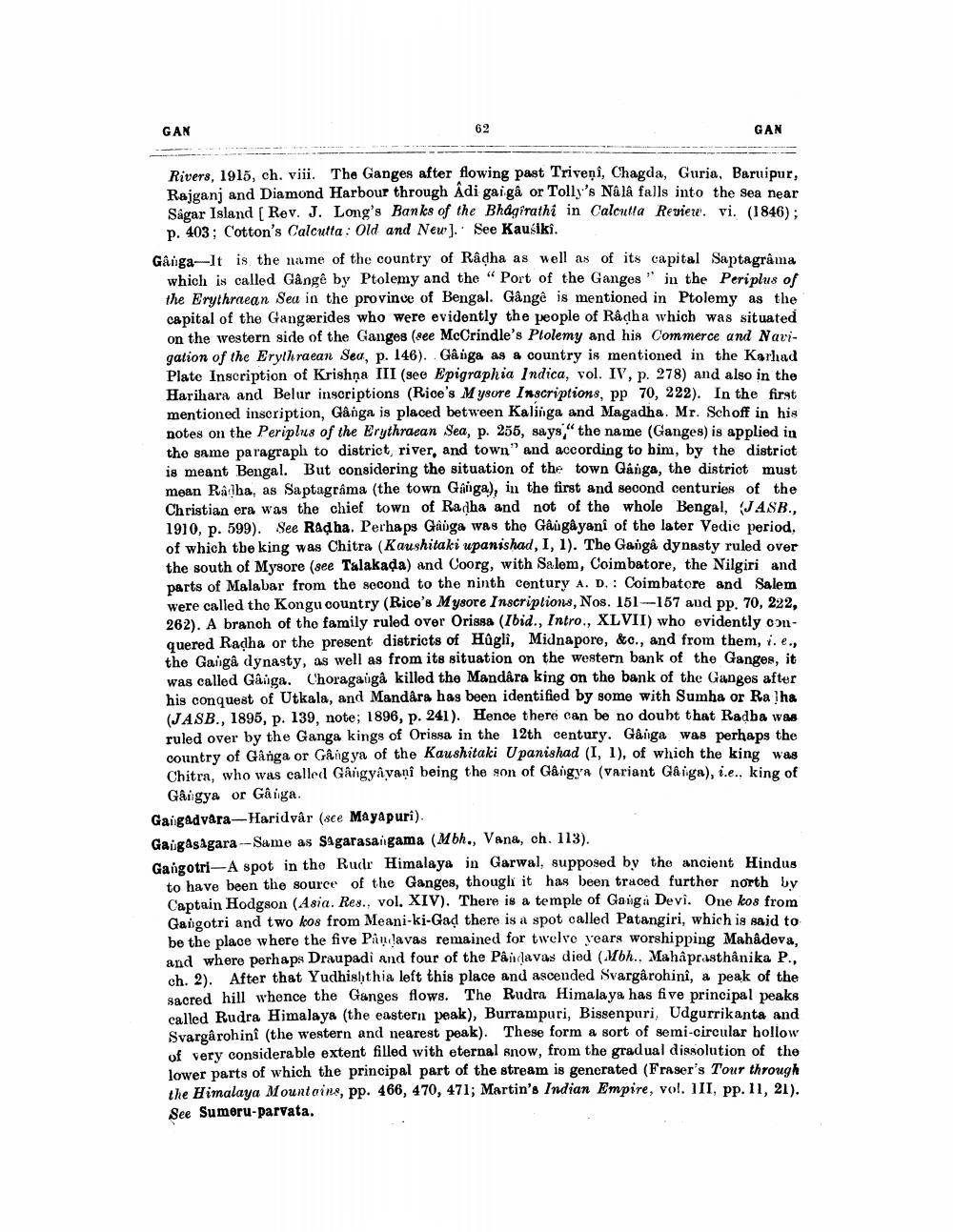________________
GAN
62
GAN
Rivers, 1915, ch. viii. The Ganges after flowing past Triveņi, Chagda, Guria, Baruipur, Rajganj and Diamond Harbour through Adi gaigâ or Tolly's Nâlâ falls into the Sea near Sågar Island ( Rev. J. Long's Banks of the Bhagirathi in Calcutla Revier. vi. (1846);
p. 403; Cotton's Calcutta : Old and New).. See Kausiki. Gâuga-t is the name of the country of Radha as well as of its capital Saptagrâma
which is called Gångê by Ptolemy and the “Port of the Ganges" in the Periplus of the Erythraean Sea in the province of Bengal. Gângê is mentioned in Ptolemy as the capital of the Gangærides who were evidently the people of Radha which was situated on the western side of the Ganges (see McCrindle's Ptolemy and his Commerce and Navigation of the Erythraean Sea, p. 146). Gânga as & country is mentioned in the Karhad Plate Inscription of Krishna III (see Epigraphia Indica, vol. IV, p. 278) and also in the Harihara and Belur inscriptions (Rice's Mysore Inscriptions, pp 70, 222). In the first mentioned inscription, Gånga is placed between Kalinga and Magadha. Mr. Schoff in his notes on the Periplus of the Erythraean Sea, p. 255, says," the name (Ganges) is applied in the same paragraph to district, river, and town” and according to bim, by the district is meant Bengal. But considering the situation of the town Gánga, the district must mean Ralha, as Saptagrama (the town Ganga), in the first and second centuries of the Christian era was the chief town of Radha and not of the whole Bengal, (JASB., 1910, p. 599). See Radha. Perhaps Gaiga was the Gâigâyani of the later Vedie period. of which the king was Chitra (Kaushitaki upanishad, I, 1). The Gangå dynasty ruled over the south of Mysore (see Talakada) and Coorg, with Salem, Coimbatore, the Nilgiri and parts of Malabar from the second to the ninth century A. D.: Coimbatore and Salem were called tho Kongu country (Rice's Mysore Inscriptions, Nos. 151-157 and pp. 70, 222, 262). A branch of the family ruled over Orissa (Ibid., Intro., XLVII) who evidently conquered Radha or the present districts of Hûgli, Midnapore, &c., and from them, i.e., the Ganga dynasty, as well as from its situation on the western bank of the Ganges, it was called Gaiga. Choragaugå killed the Mandara king on the bank of the Ganges after his conquest of Utkala, and Mandára has been identified by some with Sumba or Raha (JASB., 1895, p. 139, note; 1896, p. 241). Hence there can be no doubt that Radba was ruled over by the Ganga kings of Orissa in the 12th century. Gânga was perhaps the country of Gånga or Gangya of the Kaushitaki Upanishad (1, 1), of which the king was Chitra, who was called Gângyâyani being the son of Gângya (variant Gâiga), i.e., king of
Gângya or Gârga. Gaigadvara-Haridvar (see Mayapuri). Gaigasagara --Same as Sagarasa gama (Mbh., Vana, ch. 113). Gangotri- A spot in the Rudr Himalaya in Garwal, supposed by the ancient Hindus
to have been the source of the Ganges, though it has been traced further north by Captain Hodgson (Asia. Res., vol. XIV). There is a temple of Gangii Devi. One kos from Gangotri and two kos from Meani-ki-Gad there is a spot called Patangiri, which is said to be the place where the five Pandavas remained for twelve years worshipping Mahadeva, and where perhaps Draupadi and four of the Pandavas died Woh.. Mahậprasthånika P.. ch. 2). After that Yudhishthia left this place and ascended Svargarohini, a peak of the sacred hill whence the Ganges flows. The Rudra Himalaya has five principal peaks called Rudra Himalaya (the eastern peak), Burrampuri, Bissenpuri, Udgurrikanta and Svargarohini (the western and nearest peak). These form a sort of semi-circular hollow of very considerable extent filled with eternal snow, from the gradual dissolution of the lower parts of which the principal part of the stream is generated (Fraser's Tour through the Himalaya Mountains, pp. 466, 470, 471; Martin's Indian Empire, vol. II, pp. 11, 21). See Sumeru-parvata.




